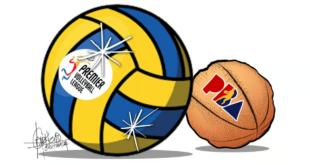 News about Gilas Pilipinas struggling in its preparations for the FIBA World Cup that the country will host from 25 August to 10 September is truly heartbreaking.
News about Gilas Pilipinas struggling in its preparations for the FIBA World Cup that the country will host from 25 August to 10 September is truly heartbreaking.
In fact, the Filipino cagers left for an all-important training in Europe without their three naturalized players and their biggest hope in the international arena.
The players’ reasons varied.
Ange Kouame claimed he has to attend his graduation at the Ateneo de Manila University on 30 June, while Justin Brownlee underwent what Gilas coach Chot Reyes described as a “non-basketball medical procedure” in the United States.
Of course, Jordan Clarkson is busy with his contract negotiation with the Utah Jazz, while Kai Sotto is bracing for the Summer League, a preseason spectacle that will give him a good chance of becoming the first full-blooded Filipino to see action in the National Basketball Association.
We have to admit that the Philippines is not a powerhouse country.
The Filipinos can’t just march into the World Cup and pluck victories as if they were some low-lying fruits. They have to compensate for their weaknesses by working hard, topped by a solid and well-defined program.
But what exactly is the program that Gilas Pilipinas is following for this year’s World Cup?
We hate to say this but — there isn’t one.
When the Samahang Basketbol ng Pilipinas bagged the honor of hosting this year’s World Cup back in December of 2017, Reyes’s first order of business was to identify the best young talents available.
He came up with 23 young players whom he will train for the biggest basketball event in the world outside of the Olympics.
Dubbed “23 for 2023,” the list was quite impressive as it featured stars from the University Athletic Association of the Philippines like Paul Desiderio of the University of the Philippines, JJ Alejandro and Troy Rike of the National University, as well as National Collegiate Athletic Association standouts like Robert Bolick and Kenmark Cariño of San Beda University and Jeo Ambohot of Letran College.
For good measure, there were some US-based players like Kobe Paras of Creighton University and Remy Martin of Arizona State University, proving that the Samahang Basketbol ng Pilipinas had done its homework in combing the world for quality talents.
But five years later, nothing has happened. Only five — AJ Edu, Kai Sotto, Dwight Ramos, Thirdy Ravena, and CJ Perez — out of the 23 players have made it to the current Gilas pool.
The failure of “23 for 2023” clearly shows the federation’s lack of vision and direction. Instead of keeping together the 23 players that Reyes identified, SBP executives just let them walk away to establish careers elsewhere.
On the side, Reyes also struggled to keep his job as the federation pressed the reset button and replaced him with foreign coaches like Tab Baldwin and Nenad Vucinic along the way.
The current system is in stark contrast to the national team program implemented during the infancy of the federation.
Then program director and head coach Rajko Toroman, the Serbian guru who masterminded Iran’s appearance in the Beijing Olympics in 2008, trekked in the same direction when he identified the country’s brightest young talents and fielded them in various international events.
His strategy was similar to that employed by the Northern Consolidated Cement-backed squad of the late Eduardo “Danding” Cojuangco in the 1980s in which the young players were kept together and were given contracts with salaries that matched those playing in the Philippine Basketball Association.
Toroman emerged successful as he turned the likes of Chris Tiu, Jayvee Casio, and Mark Barroca into the most feared guards in Asia, while role players Mark Baracael, Jayson Ballesteros and Greg Slaughter did a great job banging bodies with the giants of China and Iran.
But a few months before the 2011 FIBA Asia Men’s Championships, the federation decided to take a different direction as PBA players like Jimmy Alapag, Asi Taulava, Ranidel de Ocampo and Kelly Williams were added to the team.
Gilas Pilipinas finished fourth and Toroman was sent packing in favor of Reyes.
Now, history is repeating itself.
Reyes’s plan of keeping together 23 of the country’s best young players didn’t push through and Gilas Pilipinas is now trapped in this ugly situation of having to beg professional teams to release their players every time there is a major international event.
For a country that is overflowing with talent and a federation that has a massive war chest, begging for players should not be the case.
The SBP needs to have its own pool of players. It needs to run its own program. But no, the SBP has no program to speak of.
The “23 for 2023” roadmap was nothing but a mere fantasy, a narrative that was specifically created just to satisfy the demands of the basketball-crazy Filipinos.
*****
Credit belongs to: tribune.net.ph
 Atin Ito First Filipino Community Newspaper in Ontario
Atin Ito First Filipino Community Newspaper in Ontario






